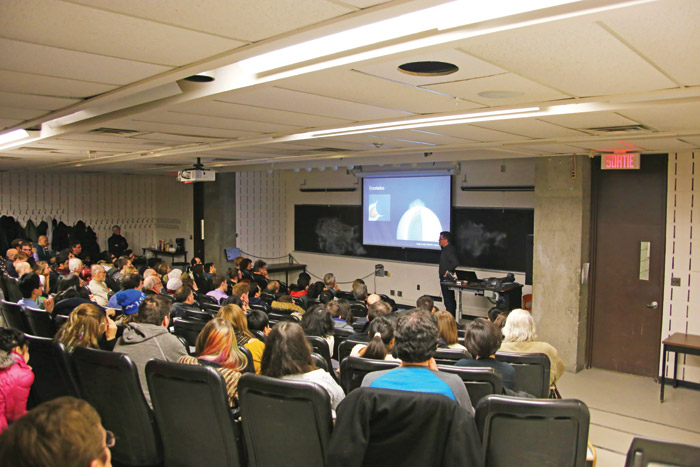On March 19, McGill students and the general Montreal public were taken on a tour of the solar system—while never leaving 103 Rutherford. Dr. Richard Léveillé, a planetary scientist who has worked on NASA’s Mars Science Laboratory mission, presented to a packed room on what scientists have learned about our planet’s neighbours.
Léveillé started the night by addressing the number one question plaguing space scientists: Why explore space?
“Space is a very dangerous venture,” Léveillé stated. “Sometimes there are risks involved; sometimes there is loss of life.”
But ultimately, as Léveillé explained, it is innate human curiosity that drives space exploration forward. By answering questions about space, people can answer questions about mankind’s very own origins.
“What are the origins and evolution of the solar system?” asked Léveillé. “Why are there all of these different bodies in the solar system? Why are they different in some ways, and why are they similar in others, and how did they get that way?”
It turns out that the search for life, though exciting, is not the driving motivator for space exploration.
“The only mission to go to another planet and search for life […] was the Viking mission in the 1970s,” said Léveillé. “The missions now are not designed to go looking for life. They’re exploring and doing all kinds of wonderful things.”
Today’s missions typically have the much more achievable goal of improving our understanding of the solar system. After its success with the moon landings, NASA has since branched out to send probes to the farthest reaches of our planetary neighbourhood, and even in the case of Voyager I, beyond the edges of the solar system.
Léveillé’s journey through the solar system started off with the closest planet to the sun—Mercury—and continued outwards to explore Venus, Mars, and Jupiter.
Each planet is incredibly unique and as technology evolves, scientists are learning new things about their surfaces. In the depths of Mercury’s craters, scientists believe there may be ice. Spaceships have allowed scientists to observe lightning in Venus’ atmosphere, and recent evidence indicates that the planet may have been more volcanically active than previously thought.
Mars is the target for a startling number of missions, including a number of orbiters and rovers such as Opportunity—whose 11-year mission was originally intended to last only a few months—and Curiosity, a project that Léveillé helped work on. Although there haven’t been any signs of life on Mars, its similarity and proximity to Earth, along with the presence of ice on its surface, make it an attractive target for missions.
Some of the more ethereal and interesting parts of the solar system lay in the moons of planets. One of Saturn’s moons, Titan, is host to both an unusually thick atmosphere and, as observed by the Cassini spacecraft, hydrocarbon seas.
“It’s so cold on Titan that you can actually condense hydrocarbons—things like methane, ethane, propane,” explained Léveillé. “On Earth we have the hydrologic [water] cycle. We think we get something similar on Titan, only with methane.”
As evidenced by Léveillé’s talk, the Earth, albeit unique, is but one wonderful planet in a wonderful solar system.








